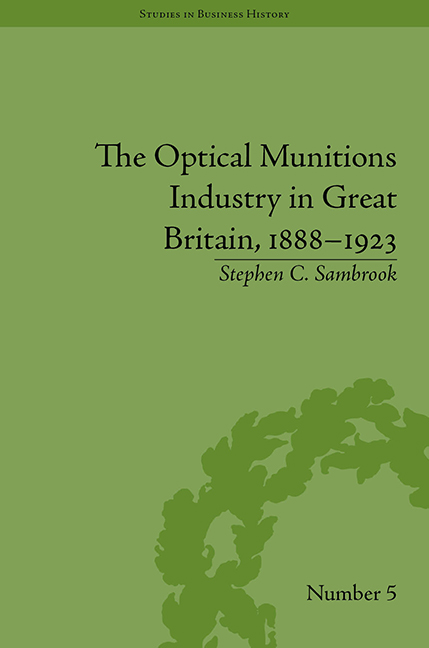Book contents
- Frontmatter
- CONTENTS
- Preface and Acknowledgements
- List of Figures and Tables
- List of Technical Terms
- Introduction
- 1 The Emergence of the Industry, 1888–99
- 2 The Growth in Importance from the Boer War to 1906
- 3 Expansion and Consolidation, 1907–14
- 4 The Impact of War, August 1914 to mid-1915
- 5 Industrial Mobilization: The Ministry of Munitions and its Relationship with the Industry
- 6 The Industry's Wartime, 1915–18
- 7 Industrial Demobilization and Implosion, 1919
- 8 Adaption and Survival, 1919–23
- Conclusion
- Notes
- Works Cited
- Index
1 - The Emergence of the Industry, 1888–99
- Frontmatter
- CONTENTS
- Preface and Acknowledgements
- List of Figures and Tables
- List of Technical Terms
- Introduction
- 1 The Emergence of the Industry, 1888–99
- 2 The Growth in Importance from the Boer War to 1906
- 3 Expansion and Consolidation, 1907–14
- 4 The Impact of War, August 1914 to mid-1915
- 5 Industrial Mobilization: The Ministry of Munitions and its Relationship with the Industry
- 6 The Industry's Wartime, 1915–18
- 7 Industrial Demobilization and Implosion, 1919
- 8 Adaption and Survival, 1919–23
- Conclusion
- Notes
- Works Cited
- Index
Summary
The story of the emergence of the optical munitions industry from 1888 to 1899 is largely about the growing importance of one instrument – the rangefinder – and the influence which the state had on the emergence of an industry for the manufacture of such specialized optical devices for use in war. The state's influence was transmitted through the activities of the War Office and the Admiralty, both of whom showed a common commitment to the idea of using optical aids but differed significantly in how they organized their acquisition and deployment. These differences changed over time and were based on a number of sometimes complex issues which included technological and tactical considerations, along with other, social, factors – reflecting particular aspects of what were really two very different military societies. That assortment of disparities meant that they proceeded along very different lines in taking up optical munitions and in the way they related to the industry on which they would increasingly come to rely. The War Office, although the first mover in taking steps that might stimulate the growth of a new industry, proved to be less inclined to seek innovation and often reluctant to move forward in the adoption of new types of optical devices.
Even if the term optical munitions would have been unfamiliar to the armed forces in the 1880s, optical instruments intended to give soldiers and sailors some form of tactical advantage in warfare had been used regularly on a small scale since the seventeenth century.
- Type
- Chapter
- Information
- Publisher: Pickering & ChattoFirst published in: 2014



